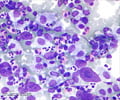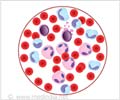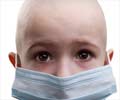- Childhood Cancer - (https://www.ncbi.nlm.nih.gov/pubmed?cmd=search&term=childhood+cancer)
- Latest Statistics Show that Global Occurrence of Childhood Cancer is Greater than Previously Thought - (http://www.acco.org/global-childhood-cancer-statistics/)
- Endocrine complications in long-term survivors of childhood cancers - (http://erc.endocrinology-journals.org/content/17/3/r141.full)
What is Childhood Cancer?
Childhood cancer is a cancer that occurs between birth and 15 years of age. It is also known as pediatric cancer. It is ranked as the number one cause of death by disease in children.
Only 1% of total cancers diagnosed are childhood cancers. The exact causes of cancer in children are not yet known.
A genetic anomaly together with certain risk factors contribute to the development of different cancers in children. Though 80% survive beyond 5 years, there is a high risk of re-occurrence and complications in adult life.
What are the Types of Childhood Cancer?
- Cancers of the bone marrow and blood [Leukemia]. These are the most common childhood cancers and account for about 30% of all cancers in children. The most common types in children are acute lymphocytic leukemia (ALL) and acute myelogenous leukemia (AML).
- Cancer of the brain and central nervous system. These are the second most common cancers in children and account for about 26-30% of childhood cancers. In children cerebellar tumors are seen more often (medulloblastoma) compared to adults.
- Cancer of nerve cells [Neuroblastoma] is found in infants and young children. They constitute 6% of childhood cancers. The tumor usually starts in the adrenal glands located on top of kidneys.
- Cancer of kidneys [Wilms tumor or nephroblastoma] accounts for about 5% of childhood cancers. It is most often found in children about 3 to 4 years old.
- Cancer of lymphocytes or infection fighting cells [Lymphoma]. This includes Hodgkin and non-Hodgkin lymphoma. They are found both in children and adults.
- Cancer of muscle cells [Rhabdomyosarcoma]. This is the most common type of soft tissue sarcoma in children and accounts for 3% of childhood cancers.
- Eye Cancer [Retinoblastoma] accounts for about 2% of childhood cancers. It usually occurs in children before the age of 5.
- Bone cancer. The 2 main types are:
- Osteosarcoma which develops in ends of long bones of legs and arms.They are usually found in older children and account for 3% of childhood cancers.
- Ewing sarcoma which normally starts in hip bones, ribs and shoulder blades, middle portion of long bones. The incidence of this type of cancer is lesser compared to osteosarcoma.
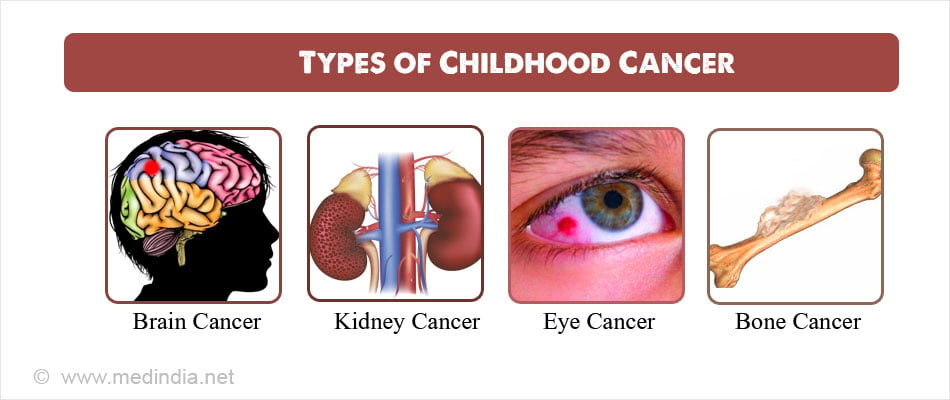
Childhood Cancer Statistics
- Childhood cancer is the number 1 cause of death due to disease.
- There are 160,000 new cases yearly. There is no reduction in the number of diagnosed cases since last 20 years.
- There are 90,000 deaths from childhood cancer every year or around 250 deaths daily.
- There are currently 14.9 cancer cases per 100,000 children.
- The average age of children diagnosed with cancer is six years.
- More than 40,000 children undergo treatment for cancer each year.
- 1 out of 8 children diagnosed with cancer will not survive beyond 5 years.
- Around 12% of children diagnosed with cancer do not survive.
- 90% of cancer deaths are due to metastasis.
- More than 80 percent of children with cancer now survive five years or more.
- 60% of children, who survive cancer, suffer from infertility, heart failure and secondary cancers in adulthood.
- There are approximately 375,000 adult survivors of children’s cancer in the United States.
- International Agency for Research on Cancer (IARC) 2016 report indicates that the global occurrence of childhood cancer may be significantly higher than previously thought.
- The report from 2001-2010, indicates that approximately 300,000 cases of cancer are diagnosed in children.
- Leukemia is the most common form of childhood cancer. It accounts for nearly half of all childhood cancers diagnosed worldwide.
- The occurrence of Burkitt lymphoma is highest in Africa where children are frequently exposed to Epstein-Barr virus and malaria.
- Kaposi sarcoma, a rare form of cancer in children has a higher rate of occurrence in countries with a high prevalence of HIV infection.
- The incidence of chronic diseases in the US Childhood Cancer Survivor Study (CCSS) was 62.3 % after follow-up for 26.6 years.
- There is a higher incidence of Non-Hodgkin’s disease, Hodgkin’s disease, acute lymphoblastic leukaemia (ALL) in males and a higher incidence of thyroid carcinoma and malignant melanoma in females.
What are the Causes of Childhood Cancer?
The exact causes of most childhood cancers are unknown. However, studies suggest the following causes:
- About 5 percent of all cancers in children are thought to develop as a result of mutations in genes inherited from a parent.
- Exposures to X ray radiation during pregnancy and prolonged sun radiation leading to sunburns have been linked with childhood cancers.
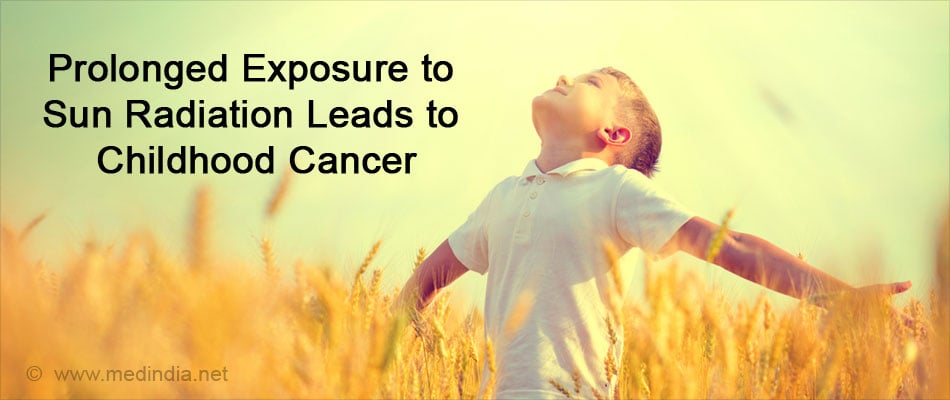
- Some studies have also suggested that tobacco smoking, exposure to second hand smoke; alcohol and marijuana use in pregnancy increases a child’s risk of certain cancers.
- Parental, maternal and childhood exposure to toxins in pesticides, household solvents are likely cause of childhood cancer.
- Repeated viral infections in children may damage genetic structure leading to cancer.
- Diethylstilbestrol drug used to maintain pregnancy was responsible for causing vaginal cancers in teenage girls.
What are the Symptoms and Signs of Childhood Cancer?
- Any unusual lump or swelling
- Continuous fever of unknown origin
- Weight loss which cannot be explained
- Frequent headaches with vomiting early in the morning
- Sudden changes in the eye and vision
- Whitish colour behind the pupil
- Constant tiredness
- Excessive bruising or bleeding
- Swelling or persistent pain in bones and joints
- Repeated infections
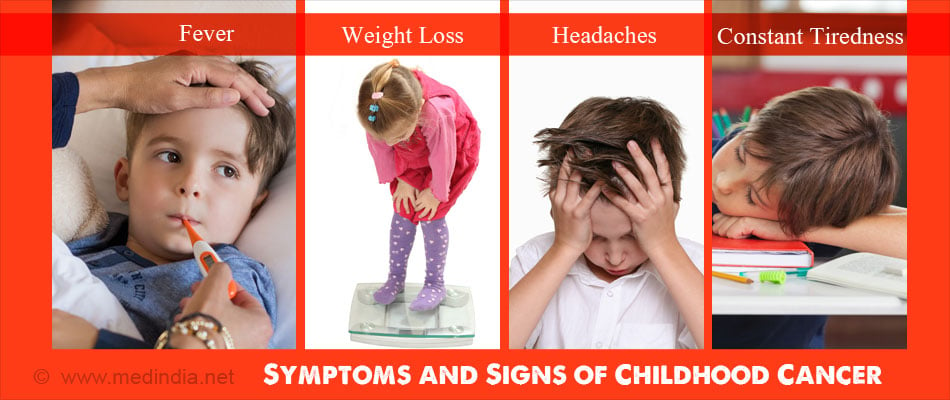
How do you Diagnose Childhood Cancer?
Primarily the doctor will ask about medical history and symptoms followed by a physical examination. Following tests may be ordered to diagnose cancer and also find out if it has spread to other parts of the body.
- Cell Blood Count [CBC] to measure the number of different types of cells in a person’s blood. Abnormal cell count may indicate the presence of cancer.
- CAT scan [Computed Tomography]to create a three-dimensional picture of the inside of the body with an x-ray machine.
- MRI [Magnetic resonance imaging] to produce detailed images of the body.
CT scan and MRI give information about location, extent of tumor, presence of lymph nodes involved by tumor and distant spread to other organs.
- Biopsy is required to make a definitive diagnosis. A small amount of tissue is excised and examined under a microscope. The presence of abnormal shape, size and arrangement of cells is diagnostic of cancer.
- Lumbar puncture may be required to detect presence of cancer cells or biomarkers. Presence of biomarker B2M [Beta-2 microglobulin)] is indicative of blood cancer and can be measured to assess response to treatment.
How do you Treat Childhood Cancer?
Once diagnosis of cancer is confirmed one or more of the following treatments may be followed depending on the type and severity of cancer:
- Surgery to remove the tumor is the treatment of choice when the cancer tumour is localized. Surgery is usually done in combination with chemotherapy and radiation.
- Chemotherapy refers to usage of drugs to kill cancer cells throughout the body via the blood stream. This treatment destroys the bone marrow, increases risk of infections and has long term effects. The pros and cons of the treatment help in deciding the dosage and duration of treatment.

- Radiation is one of the most common treatments for cancer. Streams of high-energy waves are used to kill cancer cells. It has many side effects including infertility and risk of future cancer.
- Bone Marrow Transplant is done in children with blood cancer. Healthy bone marrow is taken from a compatible donor and transferred to the patient.
- Stem cell transplant is performed in patients whose bone marrow has been destroyed by very high doses of chemotherapy or radiation. The stem cells reach bone marrow via the blood and take the place of the cells destroyed by treatment. The stem cells are obtained from the bone marrow or umbilical cord.
What are the Complications of Childhood Cancer?
Many of the complications of childhood cancers are related to treatment effects such as radiotherapy (organs in the site of radiation can be affected) and chemotherapy on various organs and tissues. The severity depends on the dose and duration of treatment. They include
- Development of secondary malignant tumor. The incidence for developing a second malignant tumor after 5 years or more is 20.5 %. This might be due to a genetic predisposition.
- Endocrine complications are most common, affecting between 20 and 50 % of individuals who survive into adulthood. These include:
- Growth hormone [GH] deficiency resulting in short stature.
- Thyroid gland complications such as hypothyroidism, autoimmune thyroid disease and thyroid cancer.
- Adverse effects on testes causing infertility in males due to impaired production of spermatozoa and the decreased production of male sex hormone. Ovarian failure results in infertility, early menopause and failure of normal pubertal development.
- Adverse effects on parathyroid and adrenal glands leading to decreased bone density and raised plasma lipids.
- Childhood cancer survivors are at an increased risk of developing diabetes mellitus.
- Childhood cancer survivors are at risk of developing auditory complications. Radiation and platinum compounds are determinants of this risk.
- The risk for cardiovascular disease in childhood cancer survivors is increased by the independent or combined exposure of radiotherapy to the thorax and anthracycline chemotherapy.
- Fibrosis and scarring of lung tissue (pulmonary fibrosis ) or lung inflammation (pneumonitis)
- Abnormal dentition such as small or missing teeth, discolored teeth, increased incidence of gum disease and cavities.
How do you Prevent Childhood Cancer?
The Centre for Disease Control [CDC’s] Division of Cancer Prevention and Control suggests that we can take following steps to reduce chances of getting cancer in the future.
- Regular medical checkups in children who have a family history of cancer.
- Eating a healthy diet during pregnancy. This includes high fiber, low fat, low salt, low sugar, 5 portions of fresh fruits and vegetables and leafy vegetables daily, whole grains and diary. Avoid cured foods as the nitrates used in the process have been linked to cancer.
- Avoid tobacco smoking, alcohol and marijuana use during pregnancy.
- Avoid parental, fetal, or childhood exposures to clinical radiation.
- Avoid excess sun exposure as a few serious sunburns can increase a child’s risk of skin cancer later in life.
- Avoid parental, fetal, or childhood exposures to toxins in pesticides and household cleaners. Also studies have linked genetically modified (GMO) foods to cancer and are best avoided.
- Encourage breastfeeding to strengthen a child’s immunity and help fight illnesses.
- Keeping children away from secondhand smoke and air pollution.
- Vaccinate girls against HPV Human papillomavirus (HPV) which causes cervical cancer.
- Vaccinate against hepatitis B to prevent childhood onset disease and lifetime risk of developing hepatic cellular carcinoma.
- Limit use of antibiotics. Frequent antibiotic usage lowers body immunity by destroying beneficial gut bacteria. This hampers body’s immune system to fight cancer.
- It is advised to have children before the age of 35. Higher the maternal age greater the chances of children developing cancer.
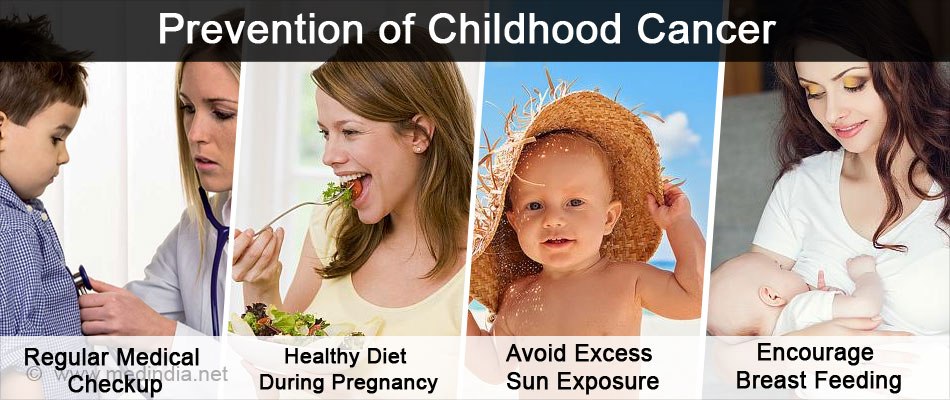
What is the Prognosis of Childhood Cancer?
Overall survival for childhood cancers has substantially increased. Nearly 80 % of children are surviving to five years following diagnosis, compared with 30 % about 50 years ago.
The incidence of chronic diseases in the US Childhood Cancer Survivor Study (CCSS) was 62.3 % after follow-up for 26.6 years.


